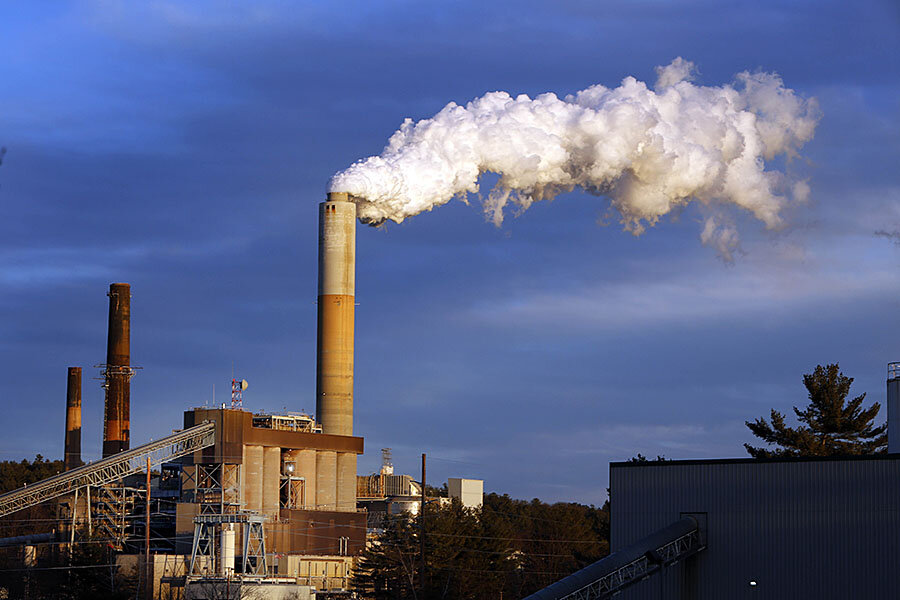Can US meet its climate goals? New study says ‘Yes’
Loading...
The world's second largest emitter has made big promises to trim output of the planet-warming gases that scientists say raise global average temperatures. The question is whether or not the US can actually follow through on its ambitious climate targets.
A study released Wednesday says it can, but success is by no means guaranteed.
Without relying on nonexistent technologies or new federal laws, the US could meet or even exceed its climate targets at little or no cost to the economy, according to an analysis released Wednesday by the World Resources Institute, a Washington-based climate research organization. The US has already taken significant steps toward meeting its goals, according to WRI, but policymakers will have to push the ball further if they want to meet its pledge to reduce its emissions by 26 percent to 28 percent below 2005 levels by 2025.
The assessment comes at a critical juncture in global climate policy. In less than six months, negotiators from across the planet will meet in Paris for what is widely seen as a last chance to foster meaningful, collective action to curb the worst effects of climate change. As the world’s largest economy, the US is expected by many across the globe to take a leadership role in those talks. It’s a role that the Obama administration has actively embraced.
“[C]onfronting climate change is now a key pillar of American global leadership,” President Obama told graduating Coast Guard cadets in a commencement speech last week. “When I meet with leaders around the world, it’s often at the top of our agenda -- a core element of our diplomacy.”
US energy-related emissions actually fell by about 8 percent between 2005 and 2012, largely due to improvements in vehicle and appliance efficiency and a transition from carbon-heavy coal to cleaner-burning natural gas in the utility sector. But they ticked back up by 2.5 percent in 2013, according to the US Energy Information Administration, and the power sector’s emissions are expected to rise through 2040 under current policies.
Last June, the Obama Administration proposed rules that would reverse that growth and cut carbon emissions in the power sector by 30 percent from 2005 levels by 2030. If finalized as proposed, the so-called Clean Power Plan would get the US about halfway toward its climate goal, according to the study's most conservative scenario. WRI outlines a variety of steps the US could take to secure the remaining reductions, which include developing new and strengthened efficiency standards for appliances and vehicles, as well as new standards for emissions of other greenhouse gases like methane and hydrofluorocarbons.
Still, the report makes it clear that without the proposed Clean Power Plan, the US would fall well short of its Intended Nationally Determined Contribution (INDC) – essentially the country's proposed contribution to global climate efforts under the United Nations Framework Convention on Climate Change.
“The power sector remains the largest single source of [US] emissions,” says Karl Hausker, lead author of WRI's report. “You can’t get any serious reductions in the US total, unless you have a strong plan for the power sector.”
But the Clean Power Plan and other federal climate initiatives have come under fierce criticism from lawmakers and industry representatives who say the policies will raise utility bills and make the electric grid less reliable.
Senate Majority Leader Mitch McConnell (R) of Kentucky has called on governors around the country to boycott the plan, and at least fifteen states are challenging the rules in court. Some legal scholars say the rules stretch or violate the limits of executive power.
“The brute fact is that the Obama administration failed to get climate legislation through Congress,” Laurence Tribe, a professor of constitutional law at Harvard Law School, wrote in an op-ed in the Wall Street Journal last December. “Yet the EPA is acting as though it has the legislative authority anyway to re-engineer the nation’s electric generating system and power grid. It does not.” Mr. Tribe has been retained by US coal giant Peabody Energy in its legal challenges to EPA’s plan.
Forty-one states are already exploring options to cut power-sector emissions under the Clean Power Plan, ClimateWire reports. Supporters point to other more immediate benefits associated with the plan, such as simultaneous reductions in other emissions that accompany burning coal – including sulfur dioxide, nitrogen oxides, mercury, and fine-grained particles. These and other benefits would be worth an estimated $55 billion to $93 billion per year in 2030, according to EPA’s estimates, far outweighing the costs of $7.3 billion to $8.8 billion.
“Every prediction that the sky is going to fall when we tackle an environmental problem has proved to be groundless,” Mr. Hausker says. “We think that will be the case for [climate change] as well.”






